
New Braunfels is a city in Comal and Guadalupe counties in the U.S. state of Texas known for its Germanic Heritage. It is the seat of Comal County.The city covers 44.9 square miles (116 km2) and has a 2018 estimated population of 84,612.
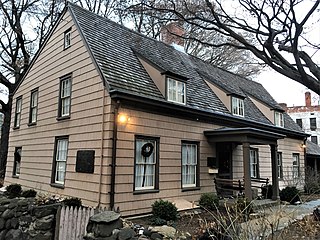
The John Bowne House is an historic home important for its role in establishing religious tolerance in the United States. It is located in the neighborhood of Flushing in Queens, New York City.

Old Fort Johnson is a historic house museum and historic site at 2 Mergner Road in Fort Johnson, New York. It is the site of Fort Johnson, a two-story stone house originally enclosed in fortifications built by Sir William Johnson about 1749. The fort served as Johnson's home, business office and trading center until 1763 when he moved to Johnson Hall in what is now Johnstown, New York. Sir William's son Sir John Johnson owned the house from 1763 until 1776, when it was confiscated by the local Committee of Safety. The house remains and is owned and operated as a museum by the Montgomery County Historical Society. It was designated a National Historic Landmark in 1972.
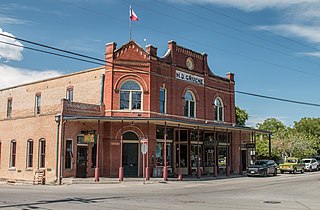
Gruene is a former town in Comal County in the U.S. state of Texas. Once a significant cotton-producing community along the Guadalupe River, the town has now shifted its economy to one supported primarily by tourism. Gruene is now a district within the city limits of New Braunfels, and much of it was listed in the National Register of Historic Places on April 21, 1975. It is part of the San Antonio-New Braunfels Metropolitan Area.
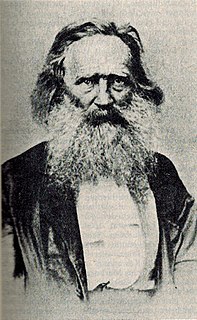
Ferdinand Jacob Lindheimer was a German Texan botanist who spent his working life on the American frontier. In 1936, Recorded Texas Historic Landmark number 1590 was placed on Lindheimer's grave.
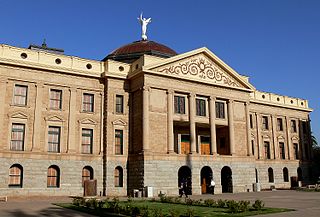
James Riely Gordon was an architect who practiced in San Antonio until 1902 and then in New York City, where he established a national reputation. J. Riely Gordon is best known for his landmark county courthouses, in particular those in Texas. Working during the state's "Golden Age" (1883–1898) of courthouse construction, Gordon saw 18 of his designs erected from 1885 to 1901; today 12 remain.

The Harriet Beecher Stowe House is a historic house museum and National Historic Landmark at 73 Forest Street in Hartford, Connecticut that was once the home of Harriet Beecher Stowe, author of Uncle Tom's Cabin. Stowe lived in this house for the last 23 years of her life. It was her family's second home in Hartford. The 5,000 sq ft cottage-style house is located adjacent to the Mark Twain House and is open to the public. It was listed on the National Register of Historic Places in 1970, and declared a National Historic Landmark in 2013.

The Sam Rayburn House Museum is a historic house museum at 890 West Texas State Highway 56 in Bonham, Fannin, Texas. Built in 1916, it was home to Sam Rayburn (1882-1961), a famously effective Speaker of the United States House of Representatives. It was declared a National Historic Landmark in 1976. Since 1972, it has been operated as a museum and state historic site by the Texas Historical Commission.

The Nicholas Gotten House is located on 2969 Court Street in Bartlett, Tennessee, United States. It houses the Bartlett Museum, a local history museum operated by the Bartlett Historical Society.

Suydam House is a historic home located at Centerport in Suffolk County, New York. It was built about 1730 and is a rectangular, five-bay, 1 1⁄2-story saltbox type building with a 1-story wing. It features a steeply pitched, asymmetrical gable roof, pierced by a brick chimney.

The Homesite of John O. Meusebach is located at Loyal Valley in Mason County, Texas, 21 miles (34 km) north of Fredericksburg and 18 miles (29 km) southeast of the city of Mason, on U.S. Highway 87 to right-of-way at the intersection of US 87 and RM 2242. Meusebach moved to the property in 1869, after a tornado destroyed his family home in Comal County.

Alfred Giles (1853–1920) was a British architect who emigrated to the United States in 1873 at the age of 20. Many of the private homes and public buildings designed by Giles are on the National Register of Historic Places and have been designated Recorded Texas Historic Landmarks. Based in San Antonio, his buildings can be found predominantly in south Texas and northern Mexico. Giles is credited with "a profound influence on architecture in San Antonio."

The Carl Wilhelm August Groos House is located in the Bexar County city of San Antonio in the U.S. state of Texas. It was designated a Recorded Texas Historic Landmark in 1977. Designed by Alfred Giles in 1880, the building contractor was John H. Kampmann. Giles used a Victorian Gothic Revival on this limestone home. Groos had immigrated from Germany to Texas in 1848, at which time he and his brothers started a freighting firm. In 1871, he built the Carl W. A. Groos House in New Braunfels. In 1872, he and his family settled in San Antonio. Groos married Hulda Amalie Moureau and became a founding member of the Groos National Bank. In 1880, Groos hired Giles to build his San Antonio home. It is listed on the National Register of Historic Places listings in Bexar County, Texas as a contributing structure of the King William Historic District. Groos died in 1893 and is interred at San Antonio City Cemetery No. 1. In 1957, the house was purchased by the San Antonio Council of the Girl Scouts of the USA. The Girl Scouts sold the home to Charles Butt. It has been restored and is in private ownership.
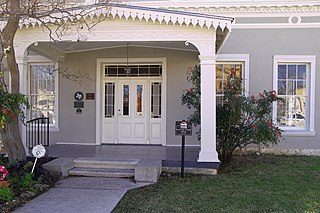
The Carl W. A. Groos House is located in the city of New Braunfels, county of Comal, in the U.S. state of Texas. It was added to the National Register of Historic Places listings in Comal County, Texas in 2000, and designated a Recorded Texas Historic Landmark in 1968. Groos occupied this house for approximately one year. He moved to San Antonio, and in 1880 had architect Alfred Giles design his home which became known as the Carl Wilhelm August Groos House. Originally owned by one of the early German emigrants to New Braunfels, the house has also remained in the hands of descendants of the early German settlers. Diplomat Bob Krueger used the building for his business office and renovated it in 1999.

The Sterne–Hoya House Museum and Library is located at 211 S. Lanana, in the city and county of Nacogdoches, in the U.S. state of Texas. It is on the National Register of Historic Places listings in Nacogdoches County and is a Recorded Texas Historic Landmark. Davy Crockett was a guest in the house, and Sam Houston was baptized in the house.

Los Nogales is a historic 1800s home, among the oldest structures still standing in Seguin, Texas and is the last remaining adobe constructed home in the city. It serves the community as a museum.

The Edward Steves Homestead is located in the Bexar County city of San Antonio in the U.S. state of Texas. It was designed by architect Alfred Giles and designated a Recorded Texas Historic Landmark. The main house was donated to the San Antonio Conservation Society in 1952. The organization completely restored the main house as a museum and now conducts daily tours. The complete homestead property consists of four individual structures: the main house museum, the carriage house, the river house, and the servants' quarters. It is listed on the National Register of Historic Places listings in Bexar County, Texas, as a contributing structure of the King William Historic District.

The Yturri–Edmunds Historic Site is a historic site in San Antonio, Texas. The house is listed on the National Register of Historic Places listings in Bexar County, Texas. The homestead and mill were designated a Recorded Texas Historic Landmark in 1966.

The Johann and Anna Heidgen House is located in the Bexar County city of San Antonio in the U.S. state of Texas. It is listed on the National Register of Historic Places listings in Bexar County, Texas. The structure was designated a Recorded Texas Historic Landmark in 2003. It is also known as the Heidgen-Zilker House. The house was built circa 1882 and has been used for a variety of purposes, including as a residence, as a youth organization facility, and at one time as a restaurant. It currently serves as the office of a San Antonio attorney.

The O. Henry House Museum is a historic house museum located in San Antonio, Texas. It is named for the American writer, William Sydney Porter, better known as O. Henry who lived in the house in 1885.

























